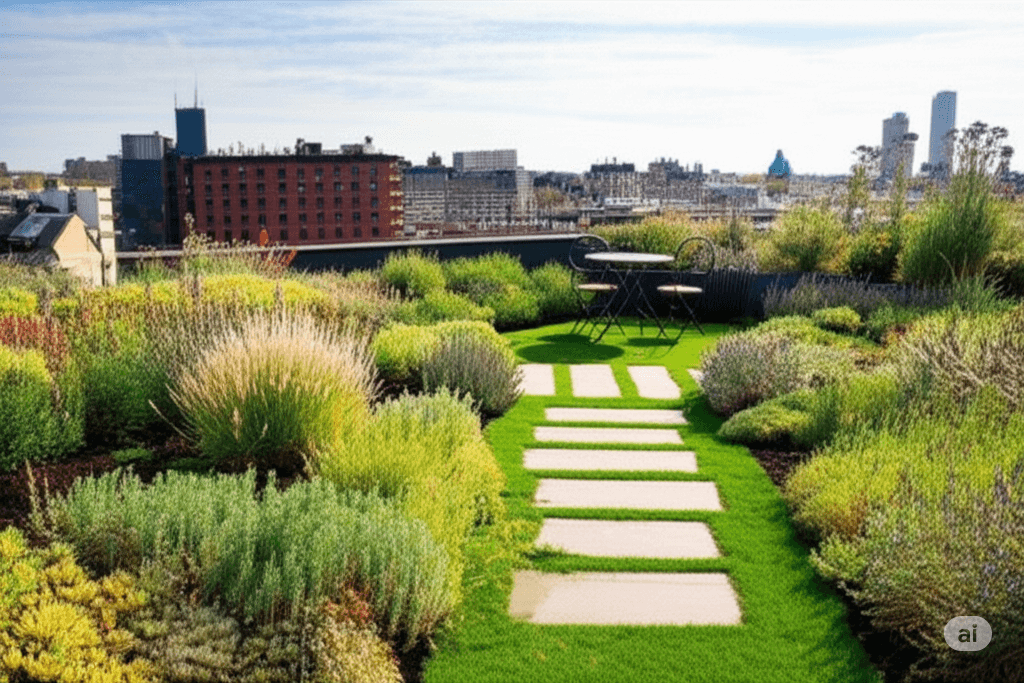Tips to Transform Your Rooftop into an Eco-Friendly Oasis

Your rooftop is often empty space, but you can turn it into a living terrace that cleans the air, cuts energy bills, and adds value to your home. Imagine sipping coffee among low-growing succulents or reading under a pergola draped in vines. This guide shows you simple steps, from planning and permissions to plant choices and upkeep, so you can build an eco-friendly rooftop oasis you'll use every season.
The Benefits of Rooftop Transformation
Turning your rooftop into a green space offers clear, practical gains you'll notice right away.
Aesthetics
You swap dull concrete for living greenery that softens your building's look. A rooftop garden becomes the ideal spot for morning coffee, evening chats, or a quiet break with a book. You choose colorful flowers, trailing vines, or ornamental grasses to match your style and local climate. Neighbors will admire your space, and guests will remember it long after they leave.
Improved Air Quality
Plants on your rooftop act like a natural air filter. They absorb carbon dioxide and release oxygen, lowering pollution around your home. By filtering tiny dust and smog particles, your garden makes outdoor time healthier for you and anyone nearby.
Reduced Energy Costs
A planted rooftop keeps heat out in summer and holds warmth in winter. Your heating and cooling system works less, and you spend less on energy. A 2024 report from the Green Roof Research Alliance showed that buildings with living roofs can lower energy use by around 20 percent. Over a year, that can shave hundreds off your utility bills.
Increased Property Value
Adding a rooftop garden boosts your home's appeal to buyers and renters. Eco-friendly features are in demand, and data shows green roofs can raise resale value. Even if you never sell, you enjoy a unique outdoor space that stands out in your neighborhood. It's an investment you can see and use every day.
How To Transform Your Rooftop into an Eco-Friendly Oasis
Follow these steps to plan and build a rooftop retreat that works for you.
Choose the Right Layout
Start by mapping your rooftop's shape and sun exposure. Decide where you want seating, walking paths, and planter beds. If you host gatherings, place chairs where the sun hits hardest in the late afternoon. If you're growing vegetables or flowers, reserve the sunniest strips for planter boxes. Plan zones for each activity to make sure every part of your roof has a clear purpose and gets the right light.
Get Permission if Needed
Before you begin, check building codes and homeowner-association rules. Many cities require written approval for added weight or changes to drainage. You might need a structural engineer to confirm your roof can handle the garden. Talk to a building official to learn about forms and inspections. Getting permits up front prevents fines, work stoppages, or removing finished sections and keeps your project on track.
Plan a Drainage System
Good drainage keeps rainwater flowing off your roof safely. Install gutters, channels, or scupper drains that direct water away from the building. Without proper drainage, water can pool, damage plants, and seep into the roof deck. Add leaf guards to keep debris from clogging drains. You can also install drip irrigation under planter trays for regular watering. A smart drainage plan protects both your garden and your home's structure.
Have a Waterproof Layer
Lay down a quality waterproof membrane beneath soil trays or planting panels. This barrier stops moisture from reaching your roof deck and causing leaks. Choose a durable material rated for rooftop gardens. Seal seams tightly and test for leaks before adding soil. A well-installed layer extends your roof's lifespan and keeps water where it belongs, in the garden above. This single step can save you thousands in repairs down the line.
Go for the Right Plants
Pick hardy species made for rooftop conditions. Succulents, sedums, and ornamental grasses handle sun, wind, and temperature swings with little care. If you have shaded corners, add ferns or hostas that thrive out of direct sun. For fragrance, plant lavender or rosemary in containers. Match each plant to its micro-climate on the roof, so you water less and enjoy more blooms. Group plants with similar needs to simplify care and irrigation.
Choose Artificial Turf
If you want a green lawn feel without mowing or fertilizing, cover part of your roof with artificial turf. Modern turf options drain well and stand up to foot traffic. You can set lounge chairs or a picnic table without worrying about muddy patches. Turf also cuts maintenance time, with no trimming or weeding. Use synthetic grass around seating areas or play zones for a soft, green surface that stays neat year-round.
Plan for Maintenance
Set aside about 30 minutes each week for upkeep. Water early in the morning or late in the evening to reduce evaporation. Check planter trays for proper drainage and clear any blocked drains. Prune dead leaves or spent blooms once a month to keep plants healthy. Inspect the waterproof layer and membrane seams each season for signs of wear. A brief routine prevents small issues from turning into costly repairs.
Your unused rooftop can be transformed into a green retreat you can enjoy every day. You'll breathe cleaner air, cut energy bills, and raise your home's value. Host friends on a soft turf patch, admire flowering plants or unwind in your private sky garden. With a little effort now, your rooftop will become your favorite spot in no time.
Published 5/20/25